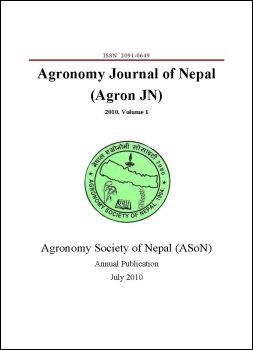Nitrogen management in zero-tillage cum surface seeded wheat at Rampur, Chitwan, Nepal
DOI:
https://doi.org/10.3126/ajn.v1i0.7547Keywords:
Surface seeding, mulch, nitrogen management, weed suppressionAbstract
An experiment was conducted at the experiment field of the Institute of Agriculture and Animal Sciences, Rampur, Chitwan, Nepal in 1999/2000 to assess the effect of mulch and the timing of nitrogen application on the performance of surface seeded wheat crop under zero-tillage condition. The experiment consisted of eight treatments that included 1/2 dose of N at sowing and 1/2 at crown root initiation (CRI) stage; 1/2 dose of N at 11 days after sowing and 1/2 at CRI; whole dose of N at CRI stage; and 1/2 dose of N at CRI and 1/2 40 days after sowing, with and without mulch using rice straw @ 4 ton/ha. The result showed that mulch was effective in conserving soil moisture, suppressing weeds and enhancing yield and yield attributing parameters. Similarly, application of nitrogen at two splits i.e. 1/2 dose of N at CRI and 1/2 at 40 days after sowing with mulch produced significantly higher grain yield (4547 kg/ha) whereas significantly lower grain yield (2267 kg/ha) was obtained from the treatment of 1/2 dose of N at sowing and 1/2 at CRI without mulch.
DOI: http://dx.doi.org/10.3126/ajn.v1i0.7547
Agronomy Journal of Nepal (Agron JN) Vol. 1: 2010 pp.85-93
Downloads
Downloads
Published
How to Cite
Issue
Section
License
ASON permits for free use, distribution and reproduction in any medium if the original work is properly cited and not used for commercial purposes.




